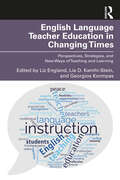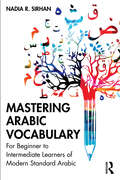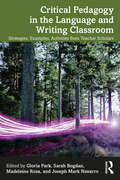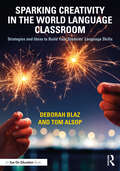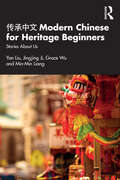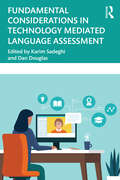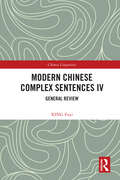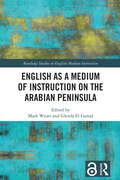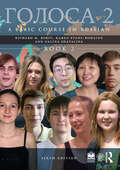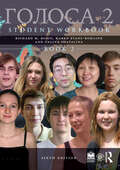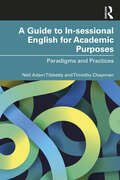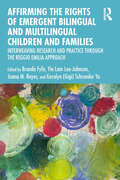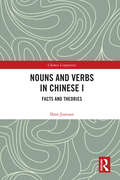- Table View
- List View
English Language Teacher Education in Changing Times: Perspectives, Strategies, and New Ways of Teaching and Learning
by Liz England Lía D. Kamhi-Stein Georgios KormpasThis volume addresses challenges that the field of English language teacher education has faced in the past several years. The global pandemic has caused extreme stress and has also served as a catalyst for new ways of teaching, learning, and leading. Educators have relied on their creativity and resiliency to identify new and innovative teaching practices and insights that inform the profession going forward. Contributors describe how teacher educators have responded to the specific needs and difficulties of educating teachers and teaching second language learners in challenging circumstances around the world and how these innovations can transform education going forward into the future. Paving the way for a revitalized profession, this book is essential reading for the current and future generations of TESOL scholars, graduate students, and professors.
Mastering Arabic Vocabulary: For Beginner to Intermediate Learners of Modern Standard Arabic
by Nadia R. SirhanMastering Arabic Vocabulary: For Beginner to Intermediate Learners of Modern Standard Arabic provides a structured vocabulary course for novice students of Arabic. Arranged thematically, and by root, the course is a flexible resource that can be used alongside other learning materials. The unique root organization supports students’ understanding of the structure of Arabic words and of the connection between form and meaning in Arabic vocabulary. The wealth of exercises throughout are designed to reinforce learning and help students gain a solid foundation in the key vocabulary needed to reach an intermediate level. Mastering Arabic Vocabulary is the ideal reference for building a strong foundation in Arabic vocabulary, for students from beginner level up to B1-B2 CEFR and ACTFL Intermediate-Low to Intermediate-High.
Mastering Arabic Vocabulary: For Beginner to Intermediate Learners of Modern Standard Arabic
by Nadia R. SirhanMastering Arabic Vocabulary: For Beginner to Intermediate Learners of Modern Standard Arabic provides a structured vocabulary course for novice students of Arabic. Arranged thematically, and by root, the course is a flexible resource that can be used alongside other learning materials. The unique root organization supports students’ understanding of the structure of Arabic words and of the connection between form and meaning in Arabic vocabulary. The wealth of exercises throughout are designed to reinforce learning and help students gain a solid foundation in the key vocabulary needed to reach an intermediate level. Mastering Arabic Vocabulary is the ideal reference for building a strong foundation in Arabic vocabulary, for students from beginner level up to B1-B2 CEFR and ACTFL Intermediate-Low to Intermediate-High.
Critical Pedagogy in the Language and Writing Classroom: Strategies, Examples, Activities from Teacher Scholars
by Gloria Park Sarah Bogdan Madeleine Rosa Joseph Mark NavarroThis volume introduces theory-to-practice-based critical pedagogy grounded in Paulo Freire’s scholarship to language and literacy learning settings. The chapters present authentic experiences of teacher-scholars, feature real-world examples and activities ready for implementation in the classroom, and provide nuanced guidance for future teachers. The examples and activities from teacher-scholars place critical pedagogy at the heart of classroom contexts and cover key topics, including place-based pedagogy, contemplative pedagogy, technology within the classroom, and translingual and multimodal paradigms. The chapters include further readings and discussion questions that challenge assumptions and promote deeper reflection, and can be modified for different teaching contexts. This practical volume is essential reading for students and scholars in TESOL and critical pedagogy.
Critical Pedagogy in the Language and Writing Classroom: Strategies, Examples, Activities from Teacher Scholars
by Gloria Park Sarah Bogdan Madeleine Rosa Joseph Mark NavarroThis volume introduces theory-to-practice-based critical pedagogy grounded in Paulo Freire’s scholarship to language and literacy learning settings. The chapters present authentic experiences of teacher-scholars, feature real-world examples and activities ready for implementation in the classroom, and provide nuanced guidance for future teachers. The examples and activities from teacher-scholars place critical pedagogy at the heart of classroom contexts and cover key topics, including place-based pedagogy, contemplative pedagogy, technology within the classroom, and translingual and multimodal paradigms. The chapters include further readings and discussion questions that challenge assumptions and promote deeper reflection, and can be modified for different teaching contexts. This practical volume is essential reading for students and scholars in TESOL and critical pedagogy.
Sparking Creativity in the World Language Classroom: Strategies and Ideas to Build Your Students’ Language Skills
by Deborah Blaz Tom AlsopJam-packed with inspiring lessons and ideas, this book will help you access and enhance your own creativity in the classroom and inspire your students to become motivated language learners. Top authors Blaz and Alsop share practical strategies to channel your creative impulses and transform them into effective lessons that will energize students of all levels. Aligned with ACTFL (American Council on the Teaching of Foreign Languages) and CEFR (Common European Framework of Reference for Languages) standards, the resources in this book support creativity as a practical process, with step-by-step guidance on goal-setting, implementation, evaluation, and feedback. Examples come from many world languages and cover fun and original topics, including tapping into students’ own interests through cooking, memes, online videos, sports, arts and crafts, and more. Relevant for all levels of language instruction, this text includes plentiful photocopiable charts, templates, and samples to use in the classroom.
Sparking Creativity in the World Language Classroom: Strategies and Ideas to Build Your Students’ Language Skills
by Deborah Blaz Tom AlsopJam-packed with inspiring lessons and ideas, this book will help you access and enhance your own creativity in the classroom and inspire your students to become motivated language learners. Top authors Blaz and Alsop share practical strategies to channel your creative impulses and transform them into effective lessons that will energize students of all levels. Aligned with ACTFL (American Council on the Teaching of Foreign Languages) and CEFR (Common European Framework of Reference for Languages) standards, the resources in this book support creativity as a practical process, with step-by-step guidance on goal-setting, implementation, evaluation, and feedback. Examples come from many world languages and cover fun and original topics, including tapping into students’ own interests through cooking, memes, online videos, sports, arts and crafts, and more. Relevant for all levels of language instruction, this text includes plentiful photocopiable charts, templates, and samples to use in the classroom.
传承中文 Modern Chinese for Heritage Beginners: Stories about Us
by Yan Liu Jingjing Ji Grace Wu Min-Min LiangModern Chinese for Heritage Beginners aims to serve as a stepping-stone for Chinese heritage language learners’ future Chinese learning, inspiring them to reflect on their identities, learn Chinese American history, and embrace their cultural heritage. The book starts with talking about individuals and families and then expands to the Chinese and Asian American communities in the U.S. and eventually to the entire American society, all from the unique perspective of Chinese American students. Taking a macro approach that builds learners’ literacy skills on their initial abilities in speaking and listening, each lesson starts with listening and speaking activities and then moves to reading and writing. The content complexity and language difficulty are balanced to present rich content that matches students’ critical thinking abilities in a language appropriate for their literacy level. Lively and humorous language makes the book a joy to read. Each lesson has a conversation and an essay to expose students to informal and formal registers. Moreover, authentic tasks are designed to facilitate students’ language output, following the three modes of communication promoted by the American Council on Teaching Foreign Languages: interpersonal, interpretive, and presentational. This theme-based Chinese textbook is written for high school and college-level Chinese heritage language learners.
传承中文 Modern Chinese for Heritage Beginners: Stories about Us
by Yan Liu Jingjing Ji Grace Wu Min-Min LiangModern Chinese for Heritage Beginners aims to serve as a stepping-stone for Chinese heritage language learners’ future Chinese learning, inspiring them to reflect on their identities, learn Chinese American history, and embrace their cultural heritage. The book starts with talking about individuals and families and then expands to the Chinese and Asian American communities in the U.S. and eventually to the entire American society, all from the unique perspective of Chinese American students. Taking a macro approach that builds learners’ literacy skills on their initial abilities in speaking and listening, each lesson starts with listening and speaking activities and then moves to reading and writing. The content complexity and language difficulty are balanced to present rich content that matches students’ critical thinking abilities in a language appropriate for their literacy level. Lively and humorous language makes the book a joy to read. Each lesson has a conversation and an essay to expose students to informal and formal registers. Moreover, authentic tasks are designed to facilitate students’ language output, following the three modes of communication promoted by the American Council on Teaching Foreign Languages: interpersonal, interpretive, and presentational. This theme-based Chinese textbook is written for high school and college-level Chinese heritage language learners.
Fundamental Considerations in Technology Mediated Language Assessment
by Karim Sadeghi Dan DouglasFundamental Considerations in Technology Mediated Language Assessment aims to address issues such as how the forced integration of technology into second language assessment has shaped our understanding of key traditional concepts like validity, reliability, washback, authenticity, ethics, fairness, test security, and more. Although computer assisted language testing has been around for more than two decades in the context of high-stakes proficiency testing, much of language testing worldwide has shifted to 'at home' mode, and relies heavily on the mediation of digital technology, making its widespread application in classroom settings in response to the COVID-19 outbreak as unprecedented. Integration of technology into language assessment has brought with it countless affordances and at the same time challenges, both theoretically and practically. One major theoretical consideration requiring attention is the way technology has contributed to a re-conceptualisation of major assessment concepts/constructs. There is very limited literature available on theoretical underpinnings of technology mediated language assessment. This book aims to fill this gap. This book will appeal to academic specialists, practitioners or professionals in the field of language assessment, advanced and/or graduate students, and a range of scholars or professionals in disciplines like educational technology, applied linguistics and TESOL.
Fundamental Considerations in Technology Mediated Language Assessment
by Karim Sadeghi and Dan DouglasFundamental Considerations in Technology Mediated Language Assessment aims to address issues such as how the forced integration of technology into second language assessment has shaped our understanding of key traditional concepts like validity, reliability, washback, authenticity, ethics, fairness, test security, and more. Although computer assisted language testing has been around for more than two decades in the context of high-stakes proficiency testing, much of language testing worldwide has shifted to 'at home' mode, and relies heavily on the mediation of digital technology, making its widespread application in classroom settings in response to the COVID-19 outbreak as unprecedented. Integration of technology into language assessment has brought with it countless affordances and at the same time challenges, both theoretically and practically. One major theoretical consideration requiring attention is the way technology has contributed to a re-conceptualisation of major assessment concepts/constructs. There is very limited literature available on theoretical underpinnings of technology mediated language assessment. This book aims to fill this gap. This book will appeal to academic specialists, practitioners or professionals in the field of language assessment, advanced and/or graduate students, and a range of scholars or professionals in disciplines like educational technology, applied linguistics and TESOL.
Modern Chinese Complex Sentences IV: General Review (Chinese Linguistics)
by XING FuyiThis book is the final volume of a four-volume set on modern Chinese complex sentences, assessing the key attributes, related sentence structures, and semantic and pragmatic relevance of complex sentences. Complex sentences in modern Chinese are unique in formation and meaning. Following on from analysis on coordinate, causal and adversative types of complex sentences, the ten chapters in this volume review the characteristics of complex sentences as a whole. The author discusses the constituents, related structures, semantic and pragmatic aspects of complex sentences, covering topics such as the constraints and counter-constraints between sentence forms and semantic relationships, six type-crossover markers, distinctions between simple sentences and complex sentences, clauses formed by a noun/nominal phrase followed by le, the shǐ-structure, subject ellipsis or tacit understanding of clauses, as well as double-subject sentences, alternative question groups and their relationships withcomplex sentences. The book will be a useful reference for scholars and learners interested in Chinese grammar and language information processing.
Modern Chinese Complex Sentences IV: General Review (Chinese Linguistics)
by XING FuyiThis book is the final volume of a four-volume set on modern Chinese complex sentences, assessing the key attributes, related sentence structures, and semantic and pragmatic relevance of complex sentences. Complex sentences in modern Chinese are unique in formation and meaning. Following on from analysis on coordinate, causal and adversative types of complex sentences, the ten chapters in this volume review the characteristics of complex sentences as a whole. The author discusses the constituents, related structures, semantic and pragmatic aspects of complex sentences, covering topics such as the constraints and counter-constraints between sentence forms and semantic relationships, six type-crossover markers, distinctions between simple sentences and complex sentences, clauses formed by a noun/nominal phrase followed by le, the shǐ-structure, subject ellipsis or tacit understanding of clauses, as well as double-subject sentences, alternative question groups and their relationships withcomplex sentences. The book will be a useful reference for scholars and learners interested in Chinese grammar and language information processing.
English as a Medium of Instruction on the Arabian Peninsula (Routledge Studies in English-Medium Instruction)
Focusing on English as a Medium of Instruction (EMI) in the Arab Gulf states, the authors consider both sociolinguistic and pedagogical perspectives, and explore practical implications. This edited volume features chapters covering how teachers are negotiating the linguistic challenges posed by EMI; issues of ownership, choice and agency; the scaffolding of academic literacies; how to support the development of content teachers’ pedagogical content knowledge in EMI settings as well as the benefits of a bilingual education. Chapter authors all have extensive local experience that they draw upon reflectively in their writing. Policy-makers, teachers and teacher educators wondering how they can best balance the need to develop competence in English in students of all ages on the Arabian Peninsula in a globalizing world, together with the concern to nurture Arabic language, culture and identity, will gain rich insights from this book. Postgraduates and researchers exploring issues surrounding EMI, both locally and internationally, will benefit from the arguments presented in this volume.
English as a Medium of Instruction on the Arabian Peninsula (Routledge Studies in English-Medium Instruction)
by Mark Wyatt Glenda El GamalFocusing on English as a Medium of Instruction (EMI) in the Arab Gulf states, the authors consider both sociolinguistic and pedagogical perspectives, and explore practical implications. This edited volume features chapters covering how teachers are negotiating the linguistic challenges posed by EMI; issues of ownership, choice and agency; the scaffolding of academic literacies; how to support the development of content teachers’ pedagogical content knowledge in EMI settings as well as the benefits of a bilingual education. Chapter authors all have extensive local experience that they draw upon reflectively in their writing. Policy-makers, teachers and teacher educators wondering how they can best balance the need to develop competence in English in students of all ages on the Arabian Peninsula in a globalizing world, together with the concern to nurture Arabic language, culture and identity, will gain rich insights from this book. Postgraduates and researchers exploring issues surrounding EMI, both locally and internationally, will benefit from the arguments presented in this volume.
Golosa: A Basic Course in Russian, Book Two
by Richard M. Robin Karen Evans-Romaine Galina ShatalinaГОЛОСА: A Basic Course in Russian, Book Two (Sixth Edition), takes a contemporary approach to language learning by focusing on the development of functional competence as well as the expansion of cultural knowledge.The sixth edition of this bestselling communicatively based text for Russian has been updated by putting a greater focus on contemporary culture and simplified, visual grammar explanations that will better engage students. The program also covers the basic morphology of Russian (declension, case government, conjugation). The program has been a bestseller as a college Russian textbook through five editions since 1993.Following on from Golosa Book One, Golosa Book Two is divided into ten units. Organised thematically, each unit contains dialogs, texts, exercises, and other material designed to enable students to read, speak, and write about the topic, as well as to understand simple conversations. The systematic grammar explanations and exercises enable students to develop a conceptual understanding and partial control of all basic Russian structures. This strong structural base enables students to accomplish the linguistic tasks and prepares them for further study of the language. Book Two is designed to bring students to the ACTFL Intermediate range in speaking (A2/B1 on the CEFR scale).Print and eTextbooks are accompanied by a Student Workbook and a rich companion website (www.routledge.com/cw/golosa) offering audio and video material, instructor resources and fully integrated exercises to use alongside the text. The companion website, powered by Lingco, is available for separate purchase from Lingco. Teachers can preview the new companion websites and create their courses. Free audio and video resources are also available at www.routledge.com/cw/golosa, including the Instructor Resources. For resources on how to set up and customize your course, please visit the Help Center on the Lingco Language Labs website at www.lingco.io. It includes articles that explain how the platform works and what you can do with it. Students may join their teacher’s course on Lingco and will be able to enter their access code or purchase access at any point in the 14-day grace period that begins on the first date of access. Students receive 12 months of access that begins after a free 14-day grace period.
Golosa: Student Workbook, Book Two
by Richard M. Robin Karen Evans-Romaine Galina ShatalinaГОЛОСА: A Basic Course in Russian, Book Two (Sixth Edition), takes a contemporary approach to language learning by focusing on the development of functional competence as well as the expansion of cultural knowledge. The sixth edition of this bestselling communicatively based text for Russian has been updated by putting a greater focus on contemporary culture and simplified, visual grammar explanations that will better engage students. The program also covers the basic morphology of Russian (declension, case government, conjugation). The program has been a bestseller as a college Russian textbook through five editions since 1993. Following on from Golosa Book One, Golosa Book Two is divided into ten units. Organised thematically, each unit contains dialogs, texts, exercises, and other material designed to enable students to read, speak, and write about the topic, as well as to understand simple conversations. The systematic grammar explanations and exercises enable students to develop a conceptual understanding and partial control of all basic Russian structures. This strong structural base enables students to accomplish the linguistic tasks and prepares them for further study of the language. Book Two is designed to bring students to the ACTFL Intermediate range in speaking (A2/B1 on the CEFR scale). Free audio and video resources are also available at www.routledge.com/9780367612825, including the Instructor Resources. Print and eTextbooks are accompanied by a Student Workbook and a rich companion website (www.routledge.com/cw/golosa) offering audio and video material, instructor resources and fully integrated exercises to use alongside the text. The companion website, powered by Lingco, is available for separate purchase from Lingco. Teachers can preview the new companion websites and create their courses. For resources on how to set up and customize your course, please visit the Help Center on the Lingco Language Labs website at www.lingco.io. It includes articles that explain how the platform works and what you can do with it. Students may join their teacher’s course on Lingco and will be able to enter their access code or purchase access at any point in the 14-day grace period that begins on the first date of access. Students receive 12 months of access that begins after a free 14-day grace period.
Golosa: A Basic Course in Russian, Book Two
by Richard M. Robin Karen Evans-Romaine Galina ShatalinaГОЛОСА: A Basic Course in Russian, Book Two (Sixth Edition), takes a contemporary approach to language learning by focusing on the development of functional competence as well as the expansion of cultural knowledge.The sixth edition of this bestselling communicatively based text for Russian has been updated by putting a greater focus on contemporary culture and simplified, visual grammar explanations that will better engage students. The program also covers the basic morphology of Russian (declension, case government, conjugation). The program has been a bestseller as a college Russian textbook through five editions since 1993.Following on from Golosa Book One, Golosa Book Two is divided into ten units. Organised thematically, each unit contains dialogs, texts, exercises, and other material designed to enable students to read, speak, and write about the topic, as well as to understand simple conversations. The systematic grammar explanations and exercises enable students to develop a conceptual understanding and partial control of all basic Russian structures. This strong structural base enables students to accomplish the linguistic tasks and prepares them for further study of the language. Book Two is designed to bring students to the ACTFL Intermediate range in speaking (A2/B1 on the CEFR scale).Print and eTextbooks are accompanied by a Student Workbook and a rich companion website (www.routledge.com/cw/golosa) offering audio and video material, instructor resources and fully integrated exercises to use alongside the text. The companion website, powered by Lingco, is available for separate purchase from Lingco. Teachers can preview the new companion websites and create their courses. Free audio and video resources are also available at www.routledge.com/cw/golosa, including the Instructor Resources. For resources on how to set up and customize your course, please visit the Help Center on the Lingco Language Labs website at www.lingco.io. It includes articles that explain how the platform works and what you can do with it. Students may join their teacher’s course on Lingco and will be able to enter their access code or purchase access at any point in the 14-day grace period that begins on the first date of access. Students receive 12 months of access that begins after a free 14-day grace period.
Golosa: Student Workbook, Book Two
by Richard M. Robin Karen Evans-Romaine Galina ShatalinaГОЛОСА: A Basic Course in Russian, Book Two (Sixth Edition), takes a contemporary approach to language learning by focusing on the development of functional competence as well as the expansion of cultural knowledge. The sixth edition of this bestselling communicatively based text for Russian has been updated by putting a greater focus on contemporary culture and simplified, visual grammar explanations that will better engage students. The program also covers the basic morphology of Russian (declension, case government, conjugation). The program has been a bestseller as a college Russian textbook through five editions since 1993. Following on from Golosa Book One, Golosa Book Two is divided into ten units. Organised thematically, each unit contains dialogs, texts, exercises, and other material designed to enable students to read, speak, and write about the topic, as well as to understand simple conversations. The systematic grammar explanations and exercises enable students to develop a conceptual understanding and partial control of all basic Russian structures. This strong structural base enables students to accomplish the linguistic tasks and prepares them for further study of the language. Book Two is designed to bring students to the ACTFL Intermediate range in speaking (A2/B1 on the CEFR scale). Free audio and video resources are also available at www.routledge.com/9780367612825, including the Instructor Resources. Print and eTextbooks are accompanied by a Student Workbook and a rich companion website (www.routledge.com/cw/golosa) offering audio and video material, instructor resources and fully integrated exercises to use alongside the text. The companion website, powered by Lingco, is available for separate purchase from Lingco. Teachers can preview the new companion websites and create their courses. For resources on how to set up and customize your course, please visit the Help Center on the Lingco Language Labs website at www.lingco.io. It includes articles that explain how the platform works and what you can do with it. Students may join their teacher’s course on Lingco and will be able to enter their access code or purchase access at any point in the 14-day grace period that begins on the first date of access. Students receive 12 months of access that begins after a free 14-day grace period.
A Guide to In-sessional English for Academic Purposes: Paradigms and Practices
by Neil Adam Tibbetts Timothy ChapmanA hands-on guide for practitioners, this book prepares instructors to teach in-sessional English for Academic Purposes (ISEAP) higher education courses. As university cohorts become more diverse, there is demand for in-sessional EAP courses not only to support international students, but also increasingly as a provision for all students. This informative resource explores the varying formats of ISEAP courses and how they are embedded within and alongside students’ degree programmes in the United Kingdom and beyond. In accessible chapters, authors Neil Adam Tibbetts and Timothy Chapman present illuminating findings drawn from interviews conducted with experts in the field and highlight the challenges that students and practitioners face. Avoiding prescriptive recommendations, Tibbetts and Chapman address different models and contexts of ISEAP courses at the university level and offer guidance and tools for practice. Covering key topics such as pedagogies, logistical challenges, and the wider university context, this book not only provides a roadmap to the often ill-defined but essential domain of ISEAP but also provokes questions and ideas for further reflection, guiding the reader towards a deeper understanding of their role and development in context. Engaging and inviting, Tibbetts and Chapman’s helpful text is a necessary resource for teachers to design and lead successful ISEAP courses.
A Guide to In-sessional English for Academic Purposes: Paradigms and Practices
by Neil Adam Tibbetts Timothy ChapmanA hands-on guide for practitioners, this book prepares instructors to teach in-sessional English for Academic Purposes (ISEAP) higher education courses. As university cohorts become more diverse, there is demand for in-sessional EAP courses not only to support international students, but also increasingly as a provision for all students. This informative resource explores the varying formats of ISEAP courses and how they are embedded within and alongside students’ degree programmes in the United Kingdom and beyond. In accessible chapters, authors Neil Adam Tibbetts and Timothy Chapman present illuminating findings drawn from interviews conducted with experts in the field and highlight the challenges that students and practitioners face. Avoiding prescriptive recommendations, Tibbetts and Chapman address different models and contexts of ISEAP courses at the university level and offer guidance and tools for practice. Covering key topics such as pedagogies, logistical challenges, and the wider university context, this book not only provides a roadmap to the often ill-defined but essential domain of ISEAP but also provokes questions and ideas for further reflection, guiding the reader towards a deeper understanding of their role and development in context. Engaging and inviting, Tibbetts and Chapman’s helpful text is a necessary resource for teachers to design and lead successful ISEAP courses.
Affirming the Rights of Emergent Bilingual and Multilingual Children and Families: Interweaving Research and Practice through the Reggio Emilia Approach
Affirming the Rights of Emergent Bilingual and Multilingual Children and Families explores how the philosophy, principles, and practices of the internationally acclaimed Municipal Preschools and Infant Toddler Centers of Reggio Emilia, Italy, advance the social justice and linguistic human rights of emergent bilingual and multilingual children and their families, particularly immigrants and refugees. The book is driven by the authors’ research-based discourse including an interview with Reggio Emilia educators and direct observations in the Preschools and Infant–toddler Centers in Italy. Chapters include survey and follow-up interviews, and classroom examples from U.S. early childhood educators inspired by the Reggio Emilia approach some of whom are in multilingual settings. Recommendations are included for practitioners who are intentional about advocating for the rights of emergent bi- and multilingual young children. Also included are the researchers’ interpretations and reflexive narratives on contextuality, intersectionality, and intertextuality, which interweave theories and practice. The insightful examinations of scholarly work and the critical review of the distinctive features of the Reggio Emilia philosophy contribute to an early childhood education transformative lens that challenges the status quo of inequities and foregrounds the linguistic and cultural rights of learners who speak different languages. The authors review research and theory that inform the latest developments in culturally and linguistically responsive practices in innovative early education (infant through pre-k), family participation, and teacher preparation and development. Of general interest to educators and researchers around the world who work to ensure the rights of emergent language learners, this is an essential text for upper-level and graduate students, early childhood educators, educational and community leaders, administrators, and researchers.
Affirming the Rights of Emergent Bilingual and Multilingual Children and Families: Interweaving Research and Practice through the Reggio Emilia Approach
by Brenda Fyfe Yin Lam Lee-Johnson Juana M. Reyes Geralyn Gigi Schroeder YuAffirming the Rights of Emergent Bilingual and Multilingual Children and Families explores how the philosophy, principles, and practices of the internationally acclaimed Municipal Preschools and Infant Toddler Centers of Reggio Emilia, Italy, advance the social justice and linguistic human rights of emergent bilingual and multilingual children and their families, particularly immigrants and refugees. The book is driven by the authors’ research-based discourse including an interview with Reggio Emilia educators and direct observations in the Preschools and Infant–toddler Centers in Italy. Chapters include survey and follow-up interviews, and classroom examples from U.S. early childhood educators inspired by the Reggio Emilia approach some of whom are in multilingual settings. Recommendations are included for practitioners who are intentional about advocating for the rights of emergent bi- and multilingual young children. Also included are the researchers’ interpretations and reflexive narratives on contextuality, intersectionality, and intertextuality, which interweave theories and practice. The insightful examinations of scholarly work and the critical review of the distinctive features of the Reggio Emilia philosophy contribute to an early childhood education transformative lens that challenges the status quo of inequities and foregrounds the linguistic and cultural rights of learners who speak different languages. The authors review research and theory that inform the latest developments in culturally and linguistically responsive practices in innovative early education (infant through pre-k), family participation, and teacher preparation and development. Of general interest to educators and researchers around the world who work to ensure the rights of emergent language learners, this is an essential text for upper-level and graduate students, early childhood educators, educational and community leaders, administrators, and researchers.
Nouns and Verbs in Chinese I: Facts and Theories (Chinese Linguistics)
by Shen JiaxuanAs the first volume of a two-volume set that re-examines nouns and verbs in Chinese, this book proposes the verbs-as-nouns theory, corroborated by discussions of the nature and relationship between nouns and verbs in Chinese. Seeking to break free from the shackles of Western linguistic paradigms largely based on Indo-European languages and to a great extent inappropriate for Chinese, this two-volume study revisits the nature of nouns and verbs and relevant linguistic categories in Chinese to unravel the different relationships between nouns and verbs in Chinese, English, and other languages. It argues that Chinese nouns and verbs are related inclusively rather than in the oppositional pattern found in Indo-European languages, with verbs included in nouns as a subcategory. Preliminary to the core discussion on the verbs-as-nouns framework, the author critically engages with the issues of word classes and nominalization, as well as problems with the analysis of Chinese grammar due to the noun-verb distinction. Through linguistic comparisons, the following chapters look into noticeable differences between Chinese and English, the referential and predicative natures of nouns and verbs, the asymmetry of the two, and the referentiality of predicates in Chinese. The volume will be a must-read for linguists and students studying Chinese linguistics, Chinese grammar, and contrastive linguistics.
Nouns and Verbs in Chinese I: Facts and Theories (Chinese Linguistics)
by Shen JiaxuanAs the first volume of a two-volume set that re-examines nouns and verbs in Chinese, this book proposes the verbs-as-nouns theory, corroborated by discussions of the nature and relationship between nouns and verbs in Chinese. Seeking to break free from the shackles of Western linguistic paradigms largely based on Indo-European languages and to a great extent inappropriate for Chinese, this two-volume study revisits the nature of nouns and verbs and relevant linguistic categories in Chinese to unravel the different relationships between nouns and verbs in Chinese, English, and other languages. It argues that Chinese nouns and verbs are related inclusively rather than in the oppositional pattern found in Indo-European languages, with verbs included in nouns as a subcategory. Preliminary to the core discussion on the verbs-as-nouns framework, the author critically engages with the issues of word classes and nominalization, as well as problems with the analysis of Chinese grammar due to the noun-verb distinction. Through linguistic comparisons, the following chapters look into noticeable differences between Chinese and English, the referential and predicative natures of nouns and verbs, the asymmetry of the two, and the referentiality of predicates in Chinese. The volume will be a must-read for linguists and students studying Chinese linguistics, Chinese grammar, and contrastive linguistics.
